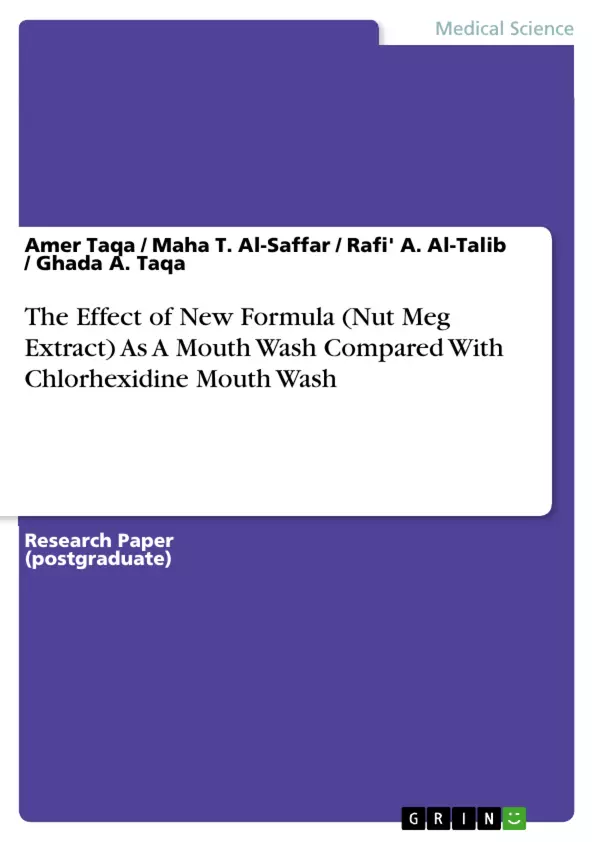Aims: To compare the anti–plaque and anti–inflammatory effects of new mouth rinse (nut meg) to the conventional chlorhexidine anti–inflammatory and anti–plaque effects (in vivo study). Materials and Methods: Sixteen dental students in the final year participated in this study (2 females and 14 males) aged 22–23 years (mean 22.5 years). A double blind study was carried out by measuring plaque index, modified gingival index and bleeding index pre–treatment and post–treatment with the two mouth rinses (nut meg and chlorhexidine). The same volunteers were participated in the two test periods and each period lasted 5 days with a wash out twice daily. Deterioration rate for each parameter was derived and used ass a unit of analysis. Results: The new mouth rinse (nut meg extract) had a significant anti–plaque and anti–inflammatory effects (measured by reduction in bleeding index), which was nearly equivalent to the anti–plaque and anti–inflammatory effects of chlorhexidine. No significant difference was noticed between post–treatment group (p > 0.05) of the two mouth rinses regarding plaque and bleeding indices. Conclusion: The nut meg extract mouth rinse had anti–inflammatory effect which encourage its use in dentistry as a new mouth rinse for the treatment of gingivitis.
Key Words: Nut meg, herbal extract, anti–inflammatory effect.
Inhaltsverzeichnis (Table of Contents)
- ABSTRACT
- INTRODUCTION
- MATERIALS AND METHODS
- Volunteer Selection
- Preparation of Nut Meg Extract
- Procedure
- RESULTS
- DISCUSSION
- CONCLUSION
- REFERENCES
Zielsetzung und Themenschwerpunkte (Objectives and Key Themes)
This study aims to compare the anti-plaque and anti-inflammatory effects of a new mouth rinse (nut meg extract) with the conventional chlorhexidine mouth rinse in an in-vivo setting.
- Efficacy of nut meg extract as a mouth rinse for plaque control
- Comparison of nut meg extract with chlorhexidine in terms of anti-plaque and anti-inflammatory properties
- Evaluation of the anti-inflammatory effect of nut meg extract on gingival tissues
- Assessment of the potential of nut meg extract as a natural alternative to chemical mouth rinses
- Exploration of the safety and side effects of nut meg extract mouth rinse
Zusammenfassung der Kapitel (Chapter Summaries)
The introduction provides background information on dental plaque, its role in gingivitis, and the limitations of mechanical plaque control methods. It highlights the need for antimicrobial agents in mouth rinses as an adjunct to oral hygiene practices. The effectiveness of chlorhexidine as an anti-plaque agent is discussed, along with its drawbacks. The study then explores the potential of nut meg extract as a natural alternative to chlorhexidine, citing its reported anti-fungal, anti-inflammatory, and antioxidant properties.
The materials and methods section details the recruitment of volunteer dental students, the preparation of the nut meg extract solution, and the experimental procedure involving a double-blind, crossover design. The study included measuring plaque index, modified gingival index, and bleeding index before and after treatment with both mouth rinses.
The results section presents the statistical analysis of the collected data, highlighting the significant anti-plaque and anti-inflammatory effects of both chlorhexidine and nut meg extract. Although both mouth rinses were effective, there was no significant difference in their post-treatment effects on plaque and bleeding indices. Notably, nut meg extract demonstrated a significant reduction in bleeding index, suggesting its anti-inflammatory potential.
The discussion section interprets the findings, comparing them with previous research on chlorhexidine and natural anti-plaque agents. It explores the potential mechanisms behind the observed anti-plaque and anti-inflammatory effects of nut meg extract, specifically highlighting its ability to inhibit prostaglandin synthesis. While the study highlights the effectiveness of nut meg extract, it also acknowledges the need for further research and investigation into the long-term effects and potential side effects.
Schlüsselwörter (Keywords)
The main keywords and focus topics of the study include nut meg extract, anti-plaque effect, anti-inflammatory effect, chlorhexidine, mouth rinse, gingivitis, natural remedies, dental plaque, oral hygiene, and clinical trial.
- Quote paper
- Amer Taqa (Author), Maha T. Al-Saffar (Author), Rafi' A. Al-Talib (Author), Ghada A. Taqa (Author), 2007, The Effect of New Formula (Nut Meg Extract) As A Mouth Wash Compared With Chlorhexidine Mouth Wash, Munich, GRIN Verlag, https://www.grin.com/document/208998



